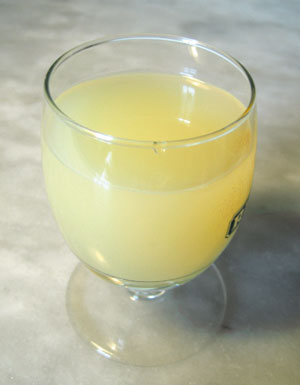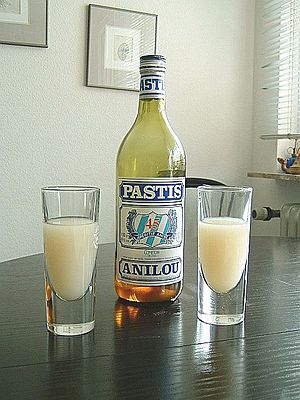Pastis facts for kids
Pastis is a popular French drink that tastes like anise (which is similar to licorice). It's a type of drink called an apéritif, which means people often drink it before a meal. Pastis usually has about 40–45% alcohol. It's very popular in France, especially in the sunny southeastern parts of the country.
Contents
How Pastis Began
Pastis was first sold by a man named Paul Ricard in 1932. It became very popular in France, especially around the city of Marseille.
This drink appeared about 17 years after another strong anise-flavored drink called absinthe was banned. People in France were still a bit worried about strong anise drinks. However, many people already loved the taste of anise, which helped pastis become so popular.
Pastis is also part of an old tradition of anise-flavored drinks from around the Mediterranean Sea. Other similar drinks include sambuca, ouzo, arak, and rakı. The name "pastis" might come from an old French word meaning "mix" or "imitation."
What's in Pastis?
By law, pastis is an anise-flavored drink that also has flavor from liquorice root. It contains less than 100 grams of sugar per liter. Most pastis has at least 40% alcohol. A special type called pastis de Marseille has at least 45% alcohol.
When it was first made, pastis was created from whole herbs. Today, most modern pastis is made by mixing alcohol with special flavorings and caramel for color.
Pastis is sometimes compared to absinthe, but they are quite different. Pastis was created after absinthe was banned. It usually doesn't contain wormwood, which is an herb found in absinthe.
Also, pastis often gets its anise flavor from star anise, which is an Asian spice. Absinthe traditionally gets its flavor from green anise and fennel, which are Mediterranean herbs. Pastis also has a taste from licorice root, which absinthe does not. Pastis usually has 40–50% alcohol, while traditional absinthes were stronger, at 45–74%.
How to Drink Pastis
Pastis is almost always mixed with water before you drink it. People usually add about five parts water for every one part of pastis. Sometimes, the pastis is served with a separate jug of water so you can mix it yourself.
When you add water, the drink changes from a clear yellow to a milky, soft yellow color. This happens because some parts of the drink become insoluble in water. This effect is also seen with absinthe and is called the "louche" or "ouzo effect".
Pastis is best enjoyed cold, especially on hot days. You can add Ice cubes, but it's best to add them after the water. This stops the ingredients from becoming solid. Many people prefer to drink pastis with cool spring water instead of ice.
Even though people drink pastis all over France, it's most famous in the southeastern parts of the country. It's especially linked to Marseille, where it's sometimes called Pastaga. It's also connected to the relaxed lifestyle of the Provençal region, like playing the game of pétanque.
About 130 million liters of pastis are sold in France every year. That's more than two liters for every person in the country!
The Science Behind the Cloudiness
Pastis drinks become cloudy when you add water because they are made with anise. These drinks contain special oils called terpenes. These oils dissolve well in alcohol solutions that have 30% alcohol or more.
When you add water, the alcohol level drops below 30%. At this point, the terpenes can no longer dissolve. This causes them to form tiny particles that make the drink look cloudy. The same scientific process makes absinthe turn cloudy when water is added.
Fun Pastis Mixes
Pastis can be used in different cocktails by adding various syrups:
- Rourou: Made with strawberry syrup.
- Tomate (French for "tomato"): Made with grenadine syrup.
- Perroquet (French for "parrot"): Made with green mint syrup.
- Mauresque (French for "Moorish"): Made with orgeat syrup.
- Feuille morte (French for "dead leaf"): Made with grenadine and green mint syrup.
- Violet: Made with lavender syrup.
- Rômarino: Made with Rosemary syrup.
- Sazerac: A classic cocktail made with cognac or rye whiskey. Pastis is sometimes used instead of absinthe in some recipes.
- Momisette: (French for “little mother” or “godmother”) Made with orgeat and orange flower water.
Well-Known Brands
Some of the famous brands of Pastis include:
- Henri Bardouin (made by Distilleries et Domaines de Provence)
- Ricard
- Pernod
- Pastis 51
- Pacific (Ricard, Pernod, Pastis 51, and Pacific are all made by Pernod Ricard)
See also
 In Spanish: Pastis para niños
In Spanish: Pastis para niños



